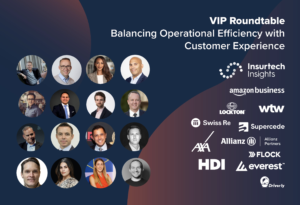Over the past 12 months, technology has entered people’s lives in new and unexpected ways with some experts saying the digital adoption we’ve experienced since March 2020 is equal to 5 years of digital gains.
At the beginning of 2020 about 20% of the U.S workforce worked from home at least one day a week, by May 2020 more than half were working from home and now almost a year later, 70% are still working from home. The way we work is only one aspect of daily life that has experienced a digital acceleration. Traffk co-founder and CEO Paul Ford says that it is time for insurance companies, especially the legacy ones, to incorporate AI assisted, data-driven insurance technology into their underwriting process or face extinction.
“For many years, the major players in the insurance industry have not had a lot of competition and so they did not think there was any need to change the way they were doing business,” said Ford. “But now the established players are becoming bogged down with paperwork and outdated models while digitally advanced insurance start-ups are having success.”
According to a Rock Health and Stanford Center for Digital Health Report, consumer adoption rates for live video telemedicine, wearable ownership and digital health metric tracking grew by more than 10 percentage points over the past year and their data suggests consumers expect technology to be an integral part of their healthcare experience.
A PwC survey found that 41% of respondents said they were likely to switch insurance providers due to a lack of digital capabilities and that 53% said they were likely to use digital channels to engage with their insurers within the next 90 days.(4) For years, the lack of digital-know-how has harmed the insurance industry and therefore its agents and consumers with outdated policies, but the COVID-19 pandemic has highlighted other ways the lack of digital adoption is hurting the industry:
Consumers were not able to get required medical exams during lockdown resulting in a backlog waiting to get life insurance—in some cases up to 3 months.
Deferred preventative healthcare could lead to a flood of claims later this year, with many companies lacking the technology to process the claims in a timely manner.
Unknown factors to the mortuary tables will result in even more outdated policy offers that consumers don’t want or need.
Agents can’t sell the way the used to and this impacts their earnings and livelihood. Face-to-face meetings and social distancing means selling insurance products online via zoom, apps, and through social networks are requisite for agents to survive and thrive.
Insurance companies that embrace new digital possibilities are the ones who will succeed in the future. Start-ups have based their model on incorporating InsurTech into the insurance process from the very beginning and have been able to transform the process of buying insurance, thus making it easy and transparent for consumers. Consumers appreciate it and are taking notice. As an example, Lemonade Insurance, in just 4 years, signed up 4 million active customers—an accomplishment that took some legacy insurance companies decades to accomplish.
Ford says that InsurTech can help insurers and reinsurers develop, design and deploy bespoke insurance products that fit consumers’ needs, boost a company’s bottom line and give agents more products to offer consumers. He says life insurance policies are a good example of how the current system is broken and losing potential clients.
“Most life insurance companies take seven factors into account when determining a person’s policy and people with conditions such as diabetes may not be able to get life insurance at all, that is 60% of the U.S. population,” said Ford. “But when we use more data to develop policies and combine that with machine learning, you can create a range to develop new policy spectrums so that if someone has a pre-existing condition, they are not rejected but put into a different class which will help companies profitably reach new audiences.”
Source: Yahoo Finance
Share this article:








